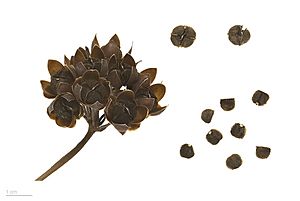Hogvine facts for kids
Quick facts for kids Hogvine |
|
|---|---|
 |
|
| Scientific classification | |
| Genus: |
Camonea
|
| Species: |
umbellata
|
| Synonyms | |
|
List
|
|
Camonea umbellata, often called hogvine, yellow merremia, or yellow wood rose, is a type of climbing plant. It is a thin vine that can grow up to 2 cm (0.79 in) thick. This plant is known for its bright yellow flowers and its many uses in traditional Indian medicine. Its flowers are also very popular with bees, butterflies, and birds.
Contents
What is Camonea Umbellata?
Camonea umbellata is a member of the morning glory family, which is called Convolvulaceae. This family includes many well-known plants like sweet potatoes. The plant is a perennial, meaning it lives for more than two years. It grows as a vine, using other plants or structures for support as it climbs.
Where Does This Plant Grow?
This plant is found in many tropical and subtropical regions around the world. You can see it growing in places like Asia, Africa, and the Americas. It often thrives in open areas, along roadsides, or in disturbed lands. It prefers warm climates and can grow quite quickly.
How to Identify Hogvine?
Camonea umbellata has several features that make it easy to spot.
- Leaves: Its leaves are usually heart-shaped or oval. They have smooth edges and can be quite large.
- Flowers: The most striking feature is its bright yellow, funnel-shaped flowers. These flowers often grow in clusters, making them very noticeable. They usually open in the morning and close by the afternoon.
- Stems: The stems are thin and flexible, allowing the plant to twine around other plants or objects.
Life Cycle and Reproduction
Like many flowering plants, Camonea umbellata reproduces using seeds. Its beautiful flowers play a key role in this process.
Pollination by Animals
The bright yellow flowers are a big draw for many animals.
- Bees: Bees visit the flowers to collect nectar and pollen. As they move from flower to flower, they help transfer pollen, which is essential for the plant to make seeds.
- Butterflies: Butterflies are also attracted to the nectar. Their long proboscis (a tube-like mouthpart) helps them reach the nectar deep inside the flower.
- Birds: Some birds, especially those that feed on nectar, might also visit the flowers.
After successful pollination, the flowers develop into small, round fruits. These fruits contain the seeds that will grow into new plants.
Traditional Uses of Yellow Merremia
For a long time, Camonea umbellata has been used in traditional Indian medicine. People believed different parts of the plant had helpful properties.
Plant Parts Used in Remedies
- Leaves: The leaves were often crushed or made into pastes.
- Roots: The roots were also used in various preparations.
- Stems: Sometimes, parts of the stem were included in traditional remedies.
It's important to remember that traditional uses are based on ancient practices. Modern medicine uses different methods and tests to confirm if a plant is safe and effective for health purposes.
Ecological Importance
Beyond its traditional uses, Camonea umbellata plays a role in its environment.
Supporting Wildlife
As mentioned, its flowers provide food for pollinators like bees and butterflies. These insects are vital for the health of many ecosystems. By attracting them, the plant helps support local wildlife.
Ground Cover
Because it grows quickly and spreads, it can sometimes act as a natural ground cover. This can help prevent soil erosion in some areas. However, in certain places, it can also spread very fast and become a weed.
See also
 In Spanish: Merremia umbellata para niños
In Spanish: Merremia umbellata para niños


